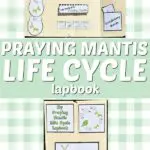If your child has a love of all things insect, this printable praying mantis life cycle lapbook is the perfect homeschool unit study activity.
Incorporate this lapbook into your spring unit studies as an engaging and fun way to learn more about backyard bugs.
This praying mantis life cycle lapbook can be used with multiple ages and adapted accordingly either by leaving off some activities for younger children or supplementing with additional material for older ones.
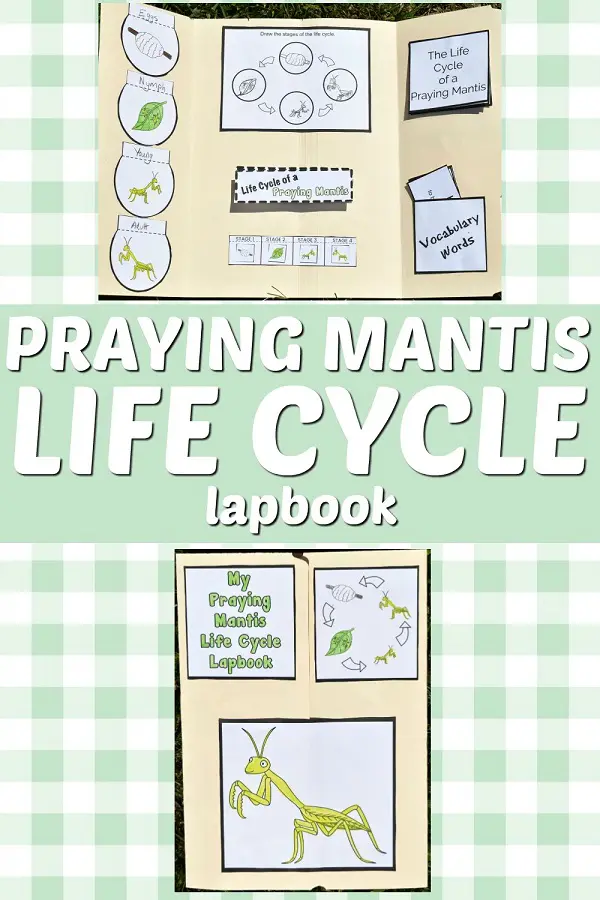
What is a lapbook?
Lapbooking allows your child to create a file folder booklet that incorporates all of the pertinent information they’ve learned about a particular topic.
This hands-on activity allows for research, discovery, and independence.
Created within the confines of a file folder, it’s also easily accessible and thorough without being overwhelming to plan and implement; which is a significant positive for busy parents.
If you don’t have a file folder available, construction paper works well too. Some families prefer to use composition books to create notebooking pages with lapbook page printables.
This is a great way to keep all of the unit studies completed, in one place. Simply cut out the lapbook activities and glue them to notebook pages rather than inside of a file folder.
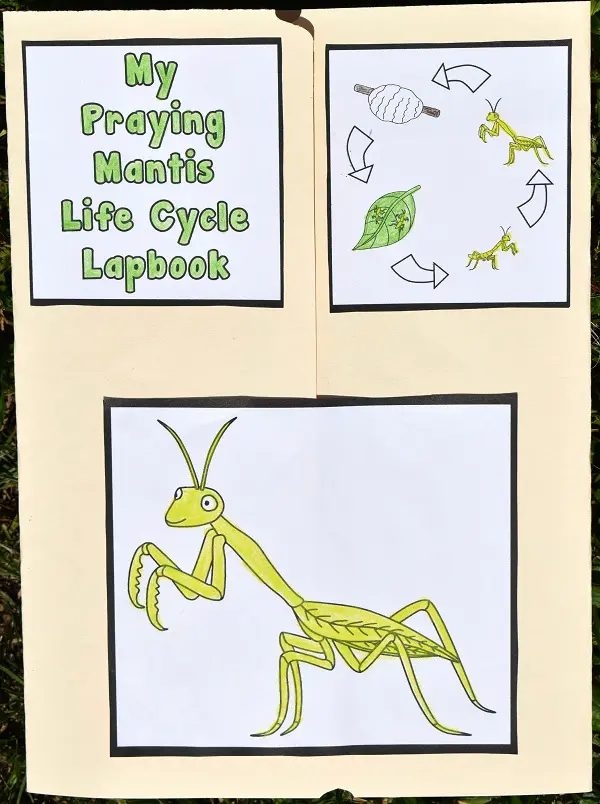
About the Praying Mantis Life Cycle
Your child will become familiar with the first stage of a praying mantis’ life, which occurs right before winter and results in 100 – 400 eggs laid after fertilization.
Older children will appreciate learning about the stages of a nymph praying mantis life called instars where their exoskeleton is shed before the third stage in the life cycle begins.
Younger kids may enjoy coloring the life cycle pages while your older students are left to do further research or watch a YouTube video about the life cycle of a praying mantis.
In the third stage of the praying mantis life cycle, the adolescent mantis sheds its exoskeleton. It lays low for a while before moving on to the fourth and final stage.
In the fourth stage, an adult praying mantis goes on to feed on mice, small birds, lizards, tree frogs, and small insects.
This post contains affiliate links. As an Amazon Associate and a participant in other affiliate programs, we earn a commission on qualifying purchases.
Arteza Kids Colored Pencils, Set of 48 Vibrant Colors, Triangular, Pre-Sharpened Crayola Classic Color Crayons in Flip-Top Pack with Sharpener, 96 Colors
Crayola Classic Color Crayons in Flip-Top Pack with Sharpener, 96 Colors Epson EcoTank ET-3710 Wireless Color Inkjet All-in-One Supertank Printer, White
Epson EcoTank ET-3710 Wireless Color Inkjet All-in-One Supertank Printer, White Crayola Erasable Colored Pencils 24 count
Crayola Erasable Colored Pencils 24 count
Praying Mantis Life Cycle Lapbook Supplies:
- File folder
- Crayons, markers, colored pencils
- Scissors
- Glue
- Praying Mantis Life Cycle Lapbook Printables (our free printables are available by filling out the form at the bottom of this post)
How to Make and Use the Praying Mantis Lapbook
Directions for putting your lapbook together are included in the printable packet. Start by opening the file folder and folding the sides in towards the middle.
Kids can color the praying mantis life cycle cover page before or after gluing it to the front of the lapbook. Each of the activities can be assembled and glued to the inside of the file folder.
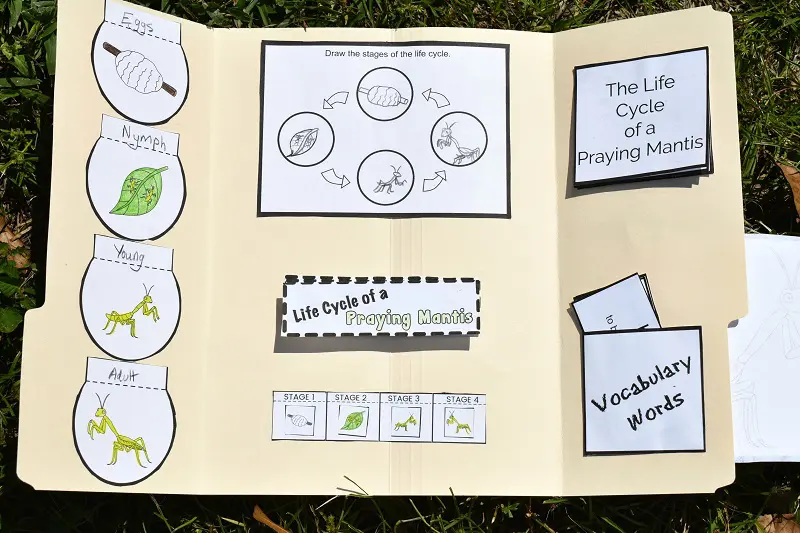
The four vocabulary words; prey, exoskeleton, hatch, abdomen, fit right into the ‘vocabulary word’ pocket that will be adhered to one side. Your child can refer to it again and again as they learn the new vocabulary.
They’ll learn the life cycle stages of the praying mantis by arranging the stages in the proper order with a cut and paste activity.
Your child also gets to both draw and label the praying mantis life cycle. This is a fun hands-on activity that will help solidify the stages of a praying mantis’ life.
It also acts as a chronicle or portfolio of their work and art project all rolled into one.
If your kids enjoyed putting this together, they may also enjoy making an alligator lapbook too.
Praying Mantis Books for Kids
Exploring the world of praying mantises through children’s literature can be both enlightening and enjoyable. Books tailored for young readers, such as Praying Mantises: Hungry Insect Heroes by Sandra Markle, provides a captivating glimpse into the life and habits of these fascinating insects.
Richly illustrated and packed with fascinating facts, these books offer an ideal balance of education and entertainment, making them perfect resources for kids researching the life cycle of a praying mantis for school projects or lapbooks.
They not only cover the basics of the praying mantis’s lifecycle from egg to adult but also introduce children to the ecological role of mantises and their unique behaviors, fostering a deeper understanding and appreciation for these incredible insects.
Praying Mantis (21st Century Junior Library: Creepy Crawly Critters)Praying Mantis Ultimate Care GuideFun Facts About Praying Mantis: 29 Frequently Asked Questions by Mantis Pet Owners & Lovers – Short Picture Book for Kids (The World of Rare Pets)My Awesome Summer by P. Mantis (A Nature Diary)Praying Mantises!: A My Incredible World Picture Book for Children (My Incredible World: Nature and Animal Picture Books for Children)Mysterious Mantises (World of Bugs)
Additional Praying Mantis Resources for Kids
The Bugs Top Trumps Card Game is a fun, quick, and educational trivia game that offers a wide variety of information about various bugs and is easy to learn to play for all ages.
If you really want to bring science to life for your kids, a praying mantis habitat kit brings the praying mantis to your home or classroom.
Your kids will love raising their own mantis and following along with their praying mantis life cycle lapbook.
Kids will also love the book, My Awesome Summer by P. Mantis, written by Paul Meisel. The book offers readers a view into the life cycle of a praying mantis.
Written in nature diary form, it follows P. Mantis through her summer and kids will learn about the praying mantis life cycle in a fun and engaging way.
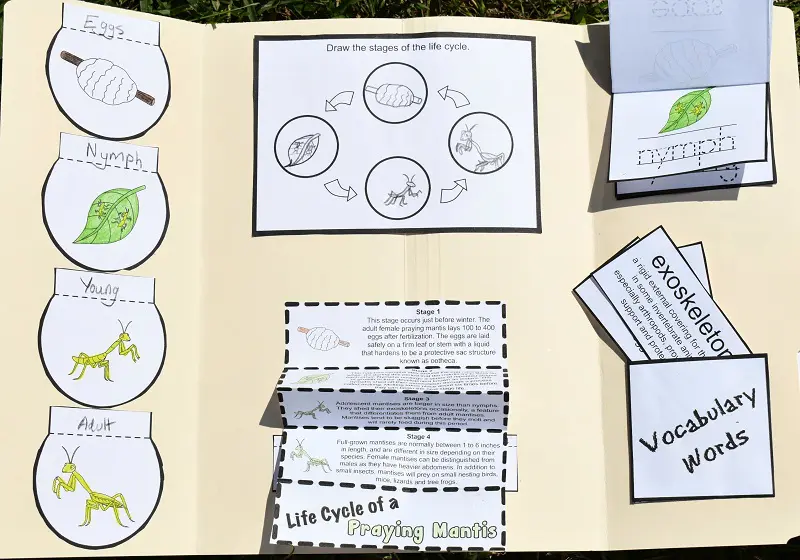
Extension Activities When Using Lapbooks
Looking for additional extension activities to incorporate alongside this praying mantis life cycle lapbook?
Consider having older children write a short story or paragraph using the vocabulary words.
Print a few extra copies of the printable page depicting the eggs, nymph, adolescent, and adult mantis and have younger children color them.
They can then glue the images onto popsicle sticks. This allows your child to tell a story or recreate the life cycle in their own words.
This retelling is a great way to reinforce what your child has learned. It also gets them thinking about the topic at hand in out-of-the-box ways.
Incorporating lapbooks into your homeschool is a great way to get kids learning in a hands-on way, creating their own educational materials and engaging with the content in a way that helps them retain it.
Plus it gets them excited about sharing the new things they learn with others; which is how you can be sure that true learning is happening.
More Life Cycle Activities for Kids:
- Ladybug Life Cycle Printables
- Butterfly Life Cycle Worksheet
- Butterfly Life Cycle Ten Frame Addition
- Bat Life Cycle Printable
Get the Praying Mantis Lapbook Printable Activities

Darcy is the founder of “Life With Darcy and Brian,” where she combines her love for education, board games, and crafting to create engaging learning experiences for kids. Her creative projects and writing have been featured in outlets like The Toy Insider, CafeMom, Mom.com, Parents.com, Country Living, and The Pioneer Woman.

